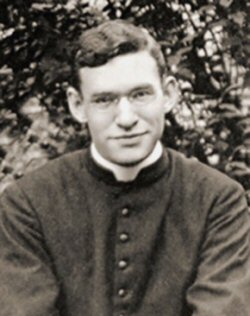Link to Dominican Nuns website - I'll post another article soon about the design and construction of their convent.
Nomads No More
From LoudounTimes.com
By: Randall Ware
"We have never had a permanent home," says Prioress Sister Mary Paul. "That is what we are most excited about."
Eight hundred years ago, St. Dominic established a Catholic religious community, known as the Dominican Order, in Toulouse, France. In 1891, a group from the Order left France for the United States, settling in Union City, N.J.
For the last 100 years, the nuns have been on the move. In 1906, members of the group in New Jersey decided to make a new foundation in Baker City, Ore. In the Pacific Northwest, however, the nuns were under pressure from the local bishop to take up teaching or nursing. Rather than give up their life of seclusion, the nuns moved to La Crosse, Wis. After many decades, pastoral care of the community lessened at La Crosse and their numbers dwindled.
In 1984, the nuns came to Washington, D.C., where they took up residence in a house in the northwest section of the city on 16th Street. As their numbers once again began to swell, the nuns enlarged the house and added a chapel, as well as a dormitory wing. Even with such additions, by 2000 the Dominicans had outgrown their home.
"They didn't have much space," noted D.C. lawyer Greg Granitto, a friend and adviser since helping the nuns move into the D.C. dwelling. "The urban area had grown up around them. It wasn't quiet."
The rural site near Linden will certainly be a change from city living. The 200-acre property, which lies in Fauquier and Warren counties, had previously been part of a family-owned apple orchard.
Fortunately for the Dominican nuns, they do not expect to have to move again. They are building their monastery according to traditional methods in the hope that it will last hundreds of years, and they'll be the first to admit that it's far from a typical, modern-day, commercial housing unit.
"It's complicated," said building superintendent John McKay, the man in charge of the project for March-Westin Construction Co. "Because it is all masonry-bearing, as opposed to steel, or wood structure, or brick veneer."
The completed monastery will be a simple facility, designed along the lines of classical monastic architecture with two stories and a basement.
The structure is being built in two phases, the first consisting of three sides of a quadrangle that will surround an inner courtyard. Historically, a monastery's courtyard is important because it provides a place to appreciate nature and God's presence.
On the outside of the quadrangle, there will be a library, a refectory, an infirmary, administrative offices, a common space and a temporary chapel. The floor above these areas will contain bedrooms, or cells, for up to 24 nuns.
Corridors, or cloisters, will separate these outer areas from the courtyard. Arched windows and doors will line both sides of the cloisters. In traditional monasteries, strict silence is observed in these pathways.
The fourth side of the quadrangle will be built during phase two of the project, which will include the construction of the monastic church, where the nuns will take daily communion. The church will face east, in orientation to the rising sun, and a side chapel for visitors and a resident chaplain's quarters will be built on this side of the quadrangle.
For monastery architect Jim O'Brien, the project is a once-in-a-lifetime opportunity. "There are not many of these out there; it's a pretty unusual project," he says. "We have had to do a lot of unlearning about the way people live, because the nuns' life is very different from ours."
O'Brien has been working with the nuns on the design since 2003. "In a monastery, you have to take into consideration that many people are living and working together. Things must be the appropriate size."
The dishwashing room, for example, had to be designed so that two people have room to wash dishes by hand and not get in each other's way, said O'Brien.
O'Brien had never before drawn plans for a monastery. During a trip to Italy he visited the San Marco Dominican monastery in Florence. "It was powerful," he said. "Not much you could borrow from that, but it was a huge inspiration."
The nuns took an active role in making sure their new home would be suitable for their needs. "I was their planning tool," said O'Brien. "They were the critics. Like all good projects, they were heavily involved. Honestly, it's their design."
The finished building will have a brick exterior. Contractors will install stained-glass windows that were saved from the house on 16th Street. The interior of the monastery will be built with concrete masonry unit, commonly referred to as cinderblock. "It will be very austere," O'Brien said, "not inconsistent with their life."
This particular group of Dominicans is even more removed from society than most nuns because they are cloistered, meaning they spend their lives within the walls of the monastery. There is a reason for their seclusion.
"Cloistered nuns do not stand with their faces turned toward the world to teach or correct," explained Granitto. "Rather, they stand, faces upturned to God, speaking words of praise and adoration. They must be hidden and unavailable because they are engrossed in a work that is unseeable."
In other words, this group feels that their purpose is to intercede for the needs of the world. They believe they are a symbol to the Church of their total commitment to God, praying seven times a day between the hours of 3:30 a.m. and 8:00 p.m.
"It is pretty radical...To live apart from the world," admitted Sister Mary Paul.
Sister Mary Paul said she grew up wanting to be a nun. After attending a Catholic high school in Rochester, N.Y., she joined the Sisters of Mercy, an active congregation. Most of the nuns in the Sisters of Mercy were teachers.
"I was an active sister for a while, but I decided I didn't want to teach," said Sister Mary Paul. She left the congregation and got a job in a bank and later, a job at a psychiatric hospital. She also entered into a relationship with a man. "But my desire to be a nun was always there."
When Sister Mary Paul was 25 years old she returned to religious life. At a monastery in Elmira, NY, she began the process of becoming a professed nun.
In order to do so, a woman spends about seven years in "formation," during which she orients herself with the members of the religious community and prepares to become a religious within that community. Afterwards, she takes her solemn vows.
According to Sister Mary Paul, most women choose to become nuns somewhere between the ages of 21 and 40. "After age 40, it is hard to adjust," she said.
Despite living in a cloistered monastery, the nuns will not be completely isolated. "We have visiting," Sister Mary Paul explained. "Especially the new sisters, they certainly have family come."
The Dominicans will also have a car and a telephone. One of the nuns, called an "extern sister" is not bound by the cloisters. She handles most of the communications with the outside world. If another nun has a need to leave the monastery, the extern sister does the driving.
The nuns will likely have a vegetable garden at their Linden home, and they hope to keep some apple trees from the orchard. A food service company, such as Sysco, will bring food to the monastery on a regular basis.
The estimated cost of the property and construction of the monastery is $6 million. These funds will come from the proceeds of the property in D.C. and private donations.
The monastery will carry a mortgage.Although the nuns operate under the mantle of the Dominican Order, they are a self-contained entity, meaning that they are financially responsible for themselves and do not receive funds from the Order or any diocese.
During their years in D.C., the nuns generated income in several ways. They did computer work for Catholic publishing organizations, as well as laundry (altar linens) for the Dominican House of Studies. Georgetown University hired them to do sewing for theater productions.
Sister Mary Paul does not know what kind of work they will find in Linden, as their circumstances limit ways they can earn money. "It is hard for a cloistered monastery to find productive labor," she said. "We don't go out. We are not teachers."
In spite of this, the Dominican sisters say that they have already made many friends and contacts in the area. The Catholic community in Front Royal was instrumental in helping the nuns find a tract of land for sale, and the ladies of St. John's Parish are collecting donations for the construction of the monastery.
Other area residents also seem to be quite happy to have the monastery in the neighborhood. "We think it's wonderful," said Liz Valiulis, who lives across the road.
Valiulis and her husband moved to a Warren County hilltop from Fairfax three years ago. "We were worried about the apple orchard," she said. "There were rumors that it would become a wild-animal park."Ralph Morris, who was the manager for the apple orchard for 46 years, is also pleased to have to nuns nearby. He helped them select a scenic site on which to put the monastery and frequently corresponds with the nuns, who are living in West Springfield, Mass. until the monastery is completed.
"Their property protects quite a bit of land," Morris said. Eighty-eight acres of the property are under easement in Warren County.
Sister Mary Paul and the nuns will be the second cloistered order in the Diocese of Arlington. The other cloistered monastery is the Order of St. Clare in Alexandria.
"To be out in a rural area will be wonderful," Sister Mary Paul anticipated. "We have always been in the city. We have fallen in love with the community in Front Royal. They have been so welcoming."It's hard not to be impressed by the nuns' determination to pursue their vocation and establish a place for future sisters. "When you consider the endeavor they have taken on with very limited resources," said O'Brien. "Their willingness to put everything in the hands of God....It is courageous."
If you are actively discerning a vocation to the Priesthood, Diaconate, Consecrated Life, or Marriage and you are looking for information to help in your discernment, BE SURE TO CHECK the section at the bottom of the right sidebar for the "labels" on all posts. By clicking on one of these labels it will take you to a page with all posts containing that subject. You will also find many links for suggested reading near the bottom of the right sidebar. Best wishes and be assured of my daily prayers for your discernment.

Subscribe to:
Post Comments (Atom)






















No comments:
Post a Comment